Whether your due date is just around the corner or still a few months away, a birthing ball can be a game-changer in your pregnancy journey. If you’re on the lookout for fun prenatal exercises to stay fit or effective techniques to prepare for labour, a birthing ball might just become your new best friend.
You can start using a birthing ball at any stage of your pregnancy, but from around 32 weeks, gentle exercises can help ease aches and pains while getting your baby into the optimal position for birth. Sceptical about the benefits? A recent study showed that using a birthing ball in labour can significantly reduce maternal pain and increase pelvic outlet space, preparing you for a smoother delivery.
We’ve chatted with top experts—a gynaecologist, pre and postnatal specialists, and a seasoned midwife—to bring you the ultimate guide on birthing balls. From birthing ball positions, exercises, and all the amazing benefits that come with using one.
What is a birthing ball?
Think of a birthing ball as a super-sized, super-durable exercise ball with a few extra features. It’s made from tough material that’s hard to puncture, and it has a non-slip surface, so you can bounce and move without worrying about it popping. These balls are larger than the ones you might use at the gym, making them extra comfy for pregnancy and labour.
Birthing balls are designed to ease your discomfort and help manage pain during labour. Plus, they’re handy even after your baby arrives. On your shopping journey, you might spot peanut-shaped balls as well. These are a bit different—they’re used while lying down, which can be especially helpful if you’ve had an epidural or need to stay in bed during labour.
What are the benefits of using a birthing ball?
Relieves discomfort
Many mums find that using a birthing ball helps alleviate common pregnancy pains, such as back and pelvic discomfort. The gentle support and movement can make it easier to stay comfortable as your body changes.
Mother & Baby’s Senior Digital Writer, Anne Lora Scagliusi, found the birthing ball to be a true lifesaver during the final weeks of her pregnancy. She appreciated how it provided comfort and helped in positioning her baby, simply by bouncing on it a few times a day. And if you're concerned about bringing your own, there’s no need to worry—the NHS provides both birthing balls and peanut balls, so you’ll have access to these helpful tools when you arrive at the hospital.
Eases labour pains
During labour, a birthing ball can help manage pain and contractions. The gentle bouncing and swaying motions are known to reduce pain intensity, providing a soothing effect that many women find beneficial.
Positions baby
Sitting or leaning on a birthing ball can encourage your baby to move into an optimal position for birth. Gentle movements, like circling your hips while on the ball, can assist in aligning your baby for a smoother delivery.
Supports pelvic muscles
A birthing ball helps open up your pelvic muscles, preparing your body for labour. This can make a significant difference in easing the labour process and making room for your baby.
Core workout
Regular use of the ball engages your core muscles, which supports you during labour and helps with recovery afterwards. The added core workout can strengthen your muscles and improve your overall posture.
What size of birthing ball do I need?
Choosing the right size birthing ball is crucial. According to Hana Pauls, a midwife at Liverpool Women’s Hospital, “You want to be able to sit with your feet comfortably flat on the ground. If you’re tip-toeing, it’s too big. If your knees are higher than your tummy, it’s too small. Ideally, your knees should be about four inches lower than your hips.”
If you're shorter than 5ft 8in, a 65cm ball is recommended.
If you’re taller, opt for a 75cm ball.
Ensure the ball can support your weight by checking the instructions on the box.
When to incorporate birthing ball exercises
Jacqui Kingswell, co-founder of the The Birthing Class and The Pilates Class, recommends starting with birthing ball exercises in the second trimester. "When you enter the second trimester, it’s important to modify some exercises to ensure you’re moving safely for you and your baby. Around this time, it’s great to also start incorporating props like the birthing ball to assist your body with movement," she says. "Pregnancy is a time of great change and every day looks different, so it’s important to find a workout routine that serves you and your body."
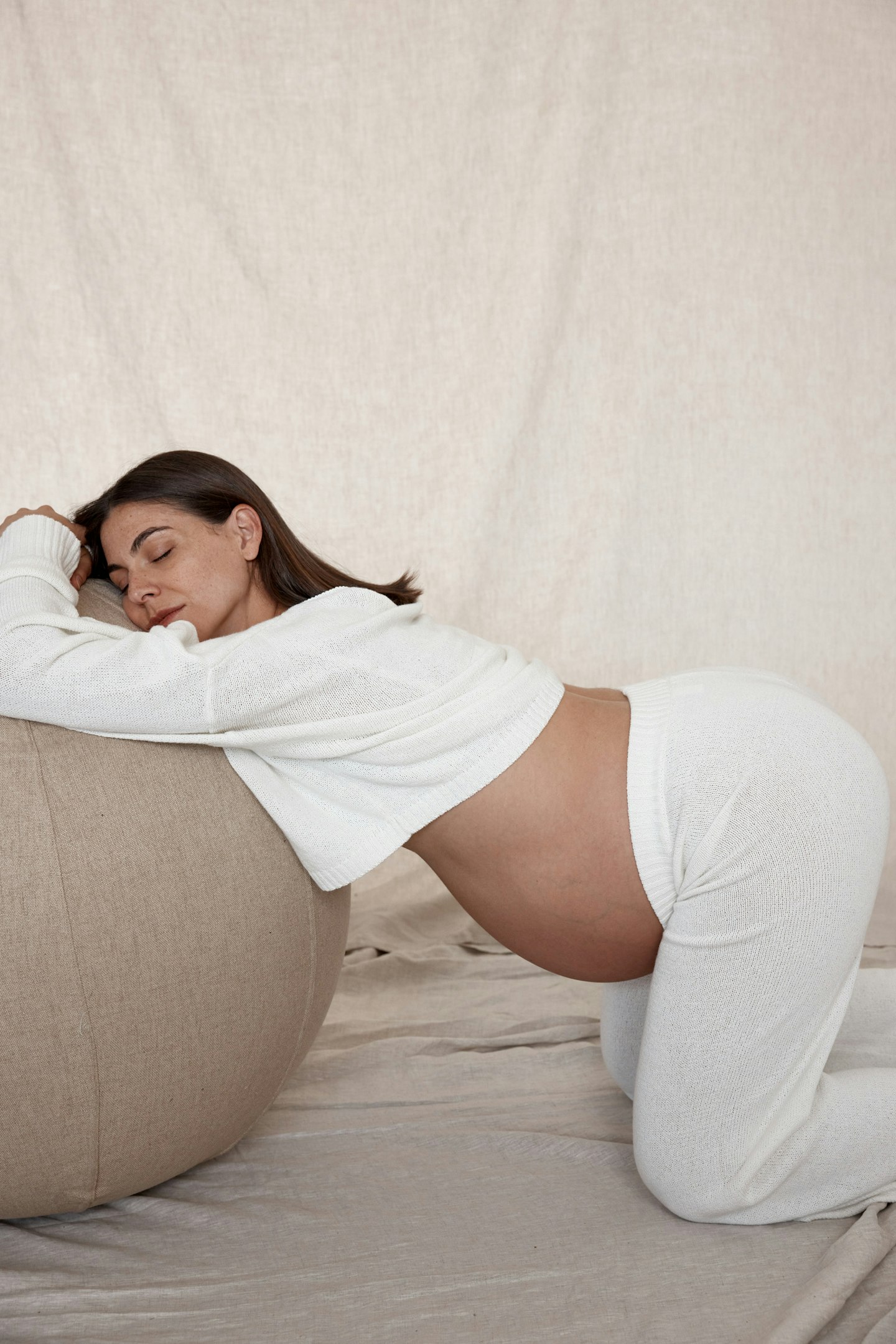
How to use a birthing ball during pregnancy and labour
During pregnancy
From around 32 weeks pregnant, start incorporating exercises with your birthing ball to prepare your body for labour, relieve muscle tension, and reduce stress. Here are some effective exercises:
Circling the hips
Sit on the ball with your legs wide and toes pointing outward.
Keep your upper body still and imagine you’re cleaning the inside of a barrel by circling your hips.
This helps position your baby and open the cervix.
Circle for 20 minutes, alternating directions.
Other exercises:
Bounce on the ball
Do squats while lifting the ball overhead
Perform sit-ups with your legs resting on the ball
During Labour
Using the birthing ball in various positions can help manage contractions:
Leaning forward
Kneel and lean on the ball for support, rocking back and forth.
Supported kneeling
Wrap your arms around the ball while rocking your pelvis side to side.
Standing support
Lean over the ball resting on your bed for extra support.
Research from the American Journal of Obstetrics and Gynecology suggests that upright positioning, such as squatting, during labour may widen the pelvic outlet, making these positions even more beneficial.
In the video below, Childbirth educator and doula, Bridget Taylor shares various birthing ball positions and techniques to prepare for and induce labour naturally.
Birthing ball exercises to try
Hollie Grant, pre and postnatal fitness expert and founder of The Bump Plan shares birthing ball exercises you can incorporate into your pregnancy fitness routine.
1. Ball Wall Squats
Using a birthing ball can make squats feel more supportive. Place the ball between the wall and your lower back. Position the ball at the lower part of your spine, just above your bum. Perform sumo squats to help open up the pelvic inlet and assist the baby in moving down, especially beneficial towards the end of pregnancy.
With feet wide and legs turned out, place your hands in a prayer position. Inhale and slowly bend your knees, using the ball for support. Go as low as comfortable while keeping your chest lifted. Exhale and push the floor away to straighten your legs without overextending.
As your feet are turned out, keep your knees in the same position. Engage your inner thighs as you push up, using the ball for additional support. Exhale as you press up and add a hold at the bottom or some pulses if you’re feeling strong.
2. Glute Bridges
A birthing ball is great for performing shoulder bridges or glute bridges. Lying flat on your back for extended periods during pregnancy can be uncomfortable, but the ball helps you stay on an incline and provides more range.
With your bum on the floor, knees bent, and feet grounded, lean back on the ball so it’s between your shoulder blades. You can rest your head back if comfortable, but keep your gaze on your knees. Reach your arms up to the ceiling and ensure you feel stable on the ball. Exhale and use your glutes to lift your hips towards the ceiling, then inhale and lower back down slowly.
Repeat the motion, exhaling as you lift and inhaling as you lower. Drive your knees forward over your toes to minimize ball movement. You can hold at the top, add some pulses, or alternate lifting legs as desired.
3. Marching
Marching on the birthing ball is a great way to activate your core and challenge pelvic stability. As your bump grows, maintaining core strength and pelvic stability becomes crucial.
Sit in the middle of the ball, with hands by your side holding the ball for extra support, or arms extended for balance. Sit up straight in a neutral position. Slowly straighten your left leg along the ground, and if comfortable, lift it off the floor and lower it back down. Slide it back in and repeat with the other leg. Alternatively, start by just lifting the foot if that feels more stable.
4. Optimal fetal positioning
In the later stages of pregnancy, spending time in a prone position (facing the floor) can help with optimal fetal positioning for a vaginal birth. This position encourages the baby to turn into the best position, with its back facing your front.
If lying on your tummy is uncomfortable, use the birthing ball to help you find a comfortable position facing the floor. You can sit back into a child's pose with knees wide or keep knees together and stick your bum up if pelvic girdle pain or lower back ache makes this position more comfortable. Rock gently back and forth for soothing relief.
5. Pelvic floor on the ball
Using a birthing ball for pelvic floor exercises can be really helpful. When you tighten your pelvic floor muscles, you should feel a lift in the area between your anus and vagina. The ball helps you notice this movement better and gives you support.
To do pelvic floor exercises, you can sit on the ball or lean over it while kneeling with forearms on the ball. Combine holds and pulses: aim for holds of 8-10 seconds, with 10 repetitions, followed by 10 pulses. Lift the pelvic floor on an exhale, focusing on lifting the anus, gripping with the vagina, and closing the urethra. Doing these exercises 2-3 times a day will strengthen your pelvic floor. Feel free to adjust these exercises to fit your comfort and capability throughout your pregnancy.
Recommended birthing ball exercises to prepare for labour
"I recommend a birthing ball around 75cm which will allow you to sit with a straight posture with your feet planted on the ground. Obviously, every ‘body’ is different, so find a size that works for you,"Jacqui suggests, "Anything you can find that suits your budget and looks like it’s sturdy enough to see you through pregnancy, birth, and beyond."
The best birthing balls in 2024 at a glance
Best birthing ball overall: nbf Birthing Ball, £19.99
Best birthing ball with guidebook: BABYGO® Birthing Ball, £29.95
Best birthing ball seat: CUB Support for Pregnancy, Labour and Birth, £120
Best birthing ball set: Tumaz Birth Ball / Exercise Ball, £34.13
The best birthing balls to buy 2024
Best birthing ball overall

Looking for a comfy and supportive birthing ball? The nbf Birthing Ball is crafted from heavyweight PVC, making it stronger and more secure than your average gym ball. It comes with a handy pump and a detailed eight-page instruction booklet. This guide includes everything from prenatal and postnatal exercises to fetal positioning tips and labor support advice, so you’ll feel well-prepared for every stage of your journey. Whether you’re lounging at home or gearing up for labor, this ball is a great addition to your pregnancy toolkit.
Our mum tester said: "The most comfy thing to sit on! It's great for lounging around the house, and I wish I had gotten one sooner."
Read our Natural Birth Fitness birthing ball review here.
Pros
- Sturdy design
- Easy to inflate
- Comes with useful accessories
Cons
- Some noticed it does lose air over time
- Pump could be higher quality
| Dimensions: | 55 up to 75cm |
| Colour: | 5 colour choices |
| Pump included: | Yes |
| Weight: | 1.3kg |
- 5 x colour choices
- 1 x hand pump
- 1 x measuring tape
Best birthing ball with guidebook
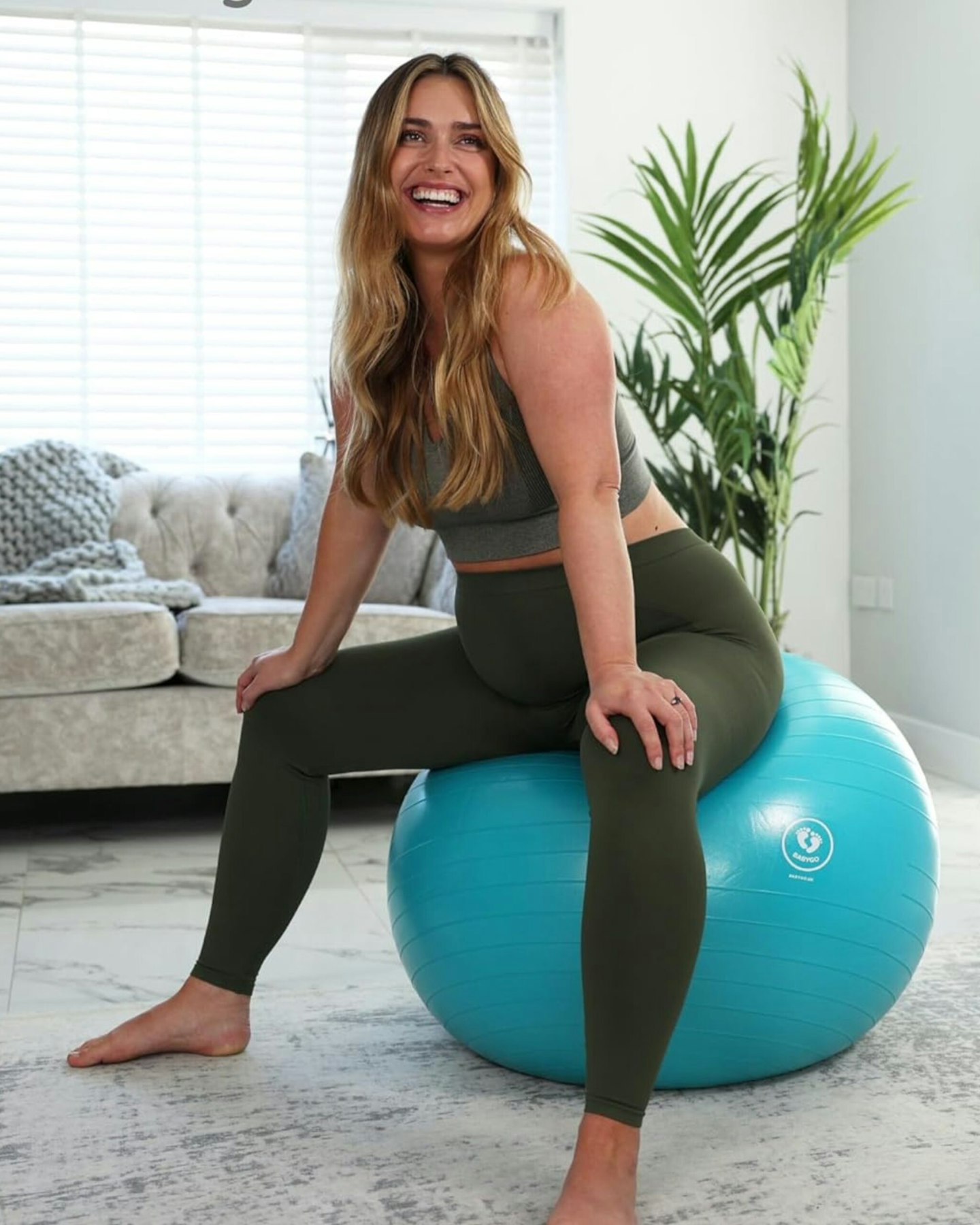
The BABYGO Birthing Ball is more than just a seat—it’s a complete support system for your pregnancy. This ball comes with a 100-page guide packed with invaluable information, including nutrition tips, labor advice, and a range of exercises. It's a fantastic tool for easing pregnancy-related aches and pains and is particularly useful for taller mums. Easy to inflate and with a size that suits most, this ball and guide combo will help you stay comfortable and informed throughout your pregnancy.
One reviewer said: "Definitely needed this! It's great for easing pregnancy aches and pains, and the guidebook is full of useful info. I’m glad I got it early on.”
Pros
- Strong and durable
- Suitable for taller individuals and easy to inflate
- Comes with a detailed 100-page guide covering all aspects of pregnancy
- Easy to inflate
- Comes with a guidebook
- Different colour options
Cons
- Some reviewers did not receive a pump
- Slightly bulkier than other options
| Dimensions: | 65 or 75cm |
| Colour: | 6 choices |
| Pump included: | No |
| Weight: | 1.8kg |
- 1 x Exercise, birth and recovery plan book
Best birthing ball seat
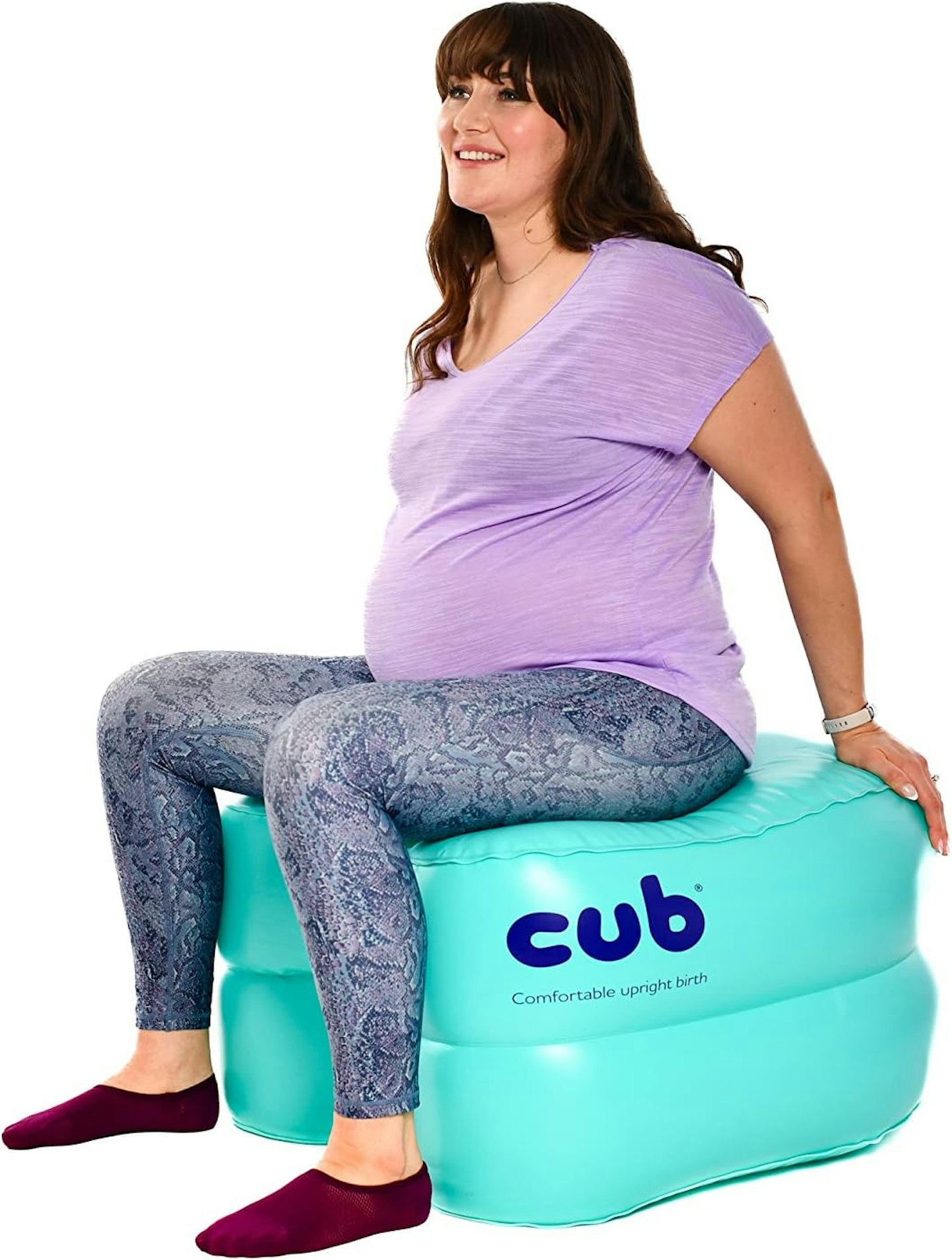
The CUB Support for Pregnancy, Labour, and Birth is a versatile tool that combines the benefits of a birthing ball with the stability of a birth stool. Designed by a midwife, it provides excellent support whether you’re at home, in a birthing unit, or at the hospital. Its robust build and flexible design make it perfect for finding comfortable and upright positions during labor, helping to facilitate a smoother and quicker delivery.
One reviewer said: "I’m a huge fan of the CUB! It’s perfect for supporting a comfortable labor position and is incredibly durable. A must-have for any home or birth unit.”
Pros
- Versatile design functions as both a birth ball and a stool
- Can be adjusted in height and weight
- Midwife-designed for comfort and support during labour
Cons
- Pump could be higher quality
- Not as comfortable as some other options
- Higher price point compared to standard birthing balls
- The unique shape might take some getting used to
| Dimensions: | 41 x 31 x 16cm |
| Colour: | Teal |
| Pump included: | Yes |
| Weight: | 2.5kg |
- 1 x manual
- 1 x inflation pump
- 1 x cotton storage bag
Best durable birthing ball
While not specifically a birthing ball, the Trideer Exercise Ball is an excellent option if you're looking for durability and strength. Available in five sizes and two colors, it comes with a quick-inflation foot pump and two air stoppers, making it a complete package. It’s robust enough to handle significant weight and regular use, making it a reliable choice for any stage of pregnancy.
One reviewer said: “I’m thrilled with this yoga ball. It’s the perfect size, supports my weight well, and feels incredibly durable. Comes with everything you need!”
Pros
- Available in multiple sizes and colours
- Highly durable and includes a foot pump and air stoppers
- Supports considerable weight, making it a long-lasting choice
Cons
- Not marketed specifically as a birthing ball, so it lacks some pregnancy-specific features
- Not as firm as some other options
- The range of sizes might be overwhelming for some
| Dimensions: | 38-45cm up to 78 - 85cm |
| Colour: | Teal and black |
| Pump included: | Yes |
| Weight: | 0.8kg |
- Slow deflation
- Non slip surface
- Extra thick and durable
- Easy to inflate
Best birthing ball set
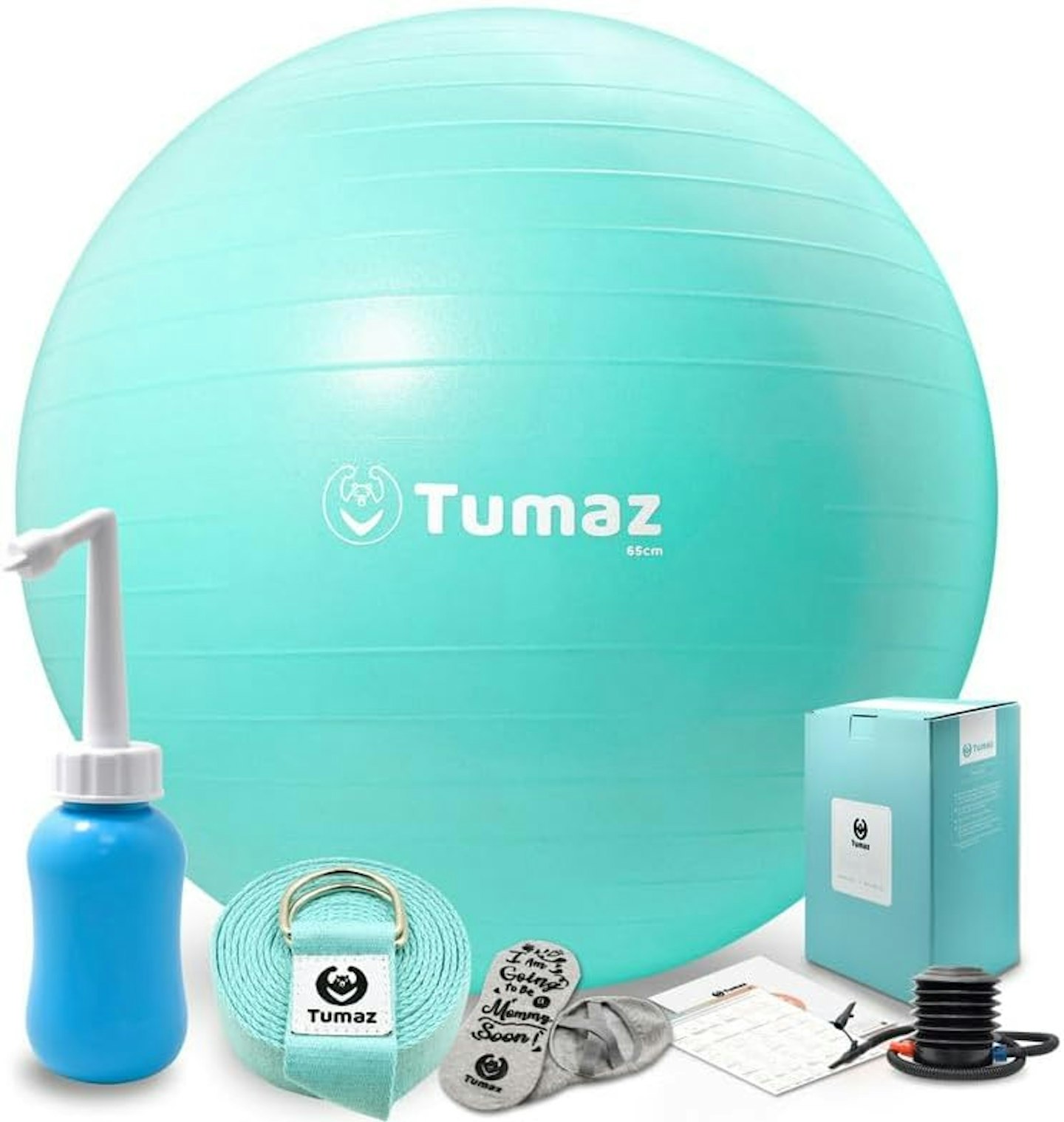
The Tumaz Birth Ball is made from high-quality anti-burst material, making it a safe and reliable choice. This set includes the ball, anti-slip socks, and a peri bottle—three essentials for your pregnancy and post-labor care. The ball is ideal for daily use to help with labor, while the peri bottle is a lifesaver for postpartum hygiene. Affordable and well-reviewed, this set is a great addition to your maternity toolkit.
One reviewer said: "“Best maternity purchase at an affordable price. Used the ball daily, and it really helped with labor. The peri bottle was fantastic for post-labor care. Totally recommend!”
Pros
- Comes with all the essentials
- Supports prenatal and postnatal
- Affordable and highly rated
- Easy to inflate
Cons
- Some reviewers reported that it may lose air over time
- Anti-slip socks may not fit everyone comfortably
- The set includes items that may not be needed by everyone
| Dimensions: | 58-65cm |
| Colour: | 3 choices |
| Pump included: | Yes |
| Weight: | 1.9kg |
- 1 x peri bottle
- 1 x birthing ball
- 1 x anti slip socks
- 2 x air plugs
- 1 x foot pump
- 1 x plug remover
- 1 x yoga strap
Best peanut birthing ball
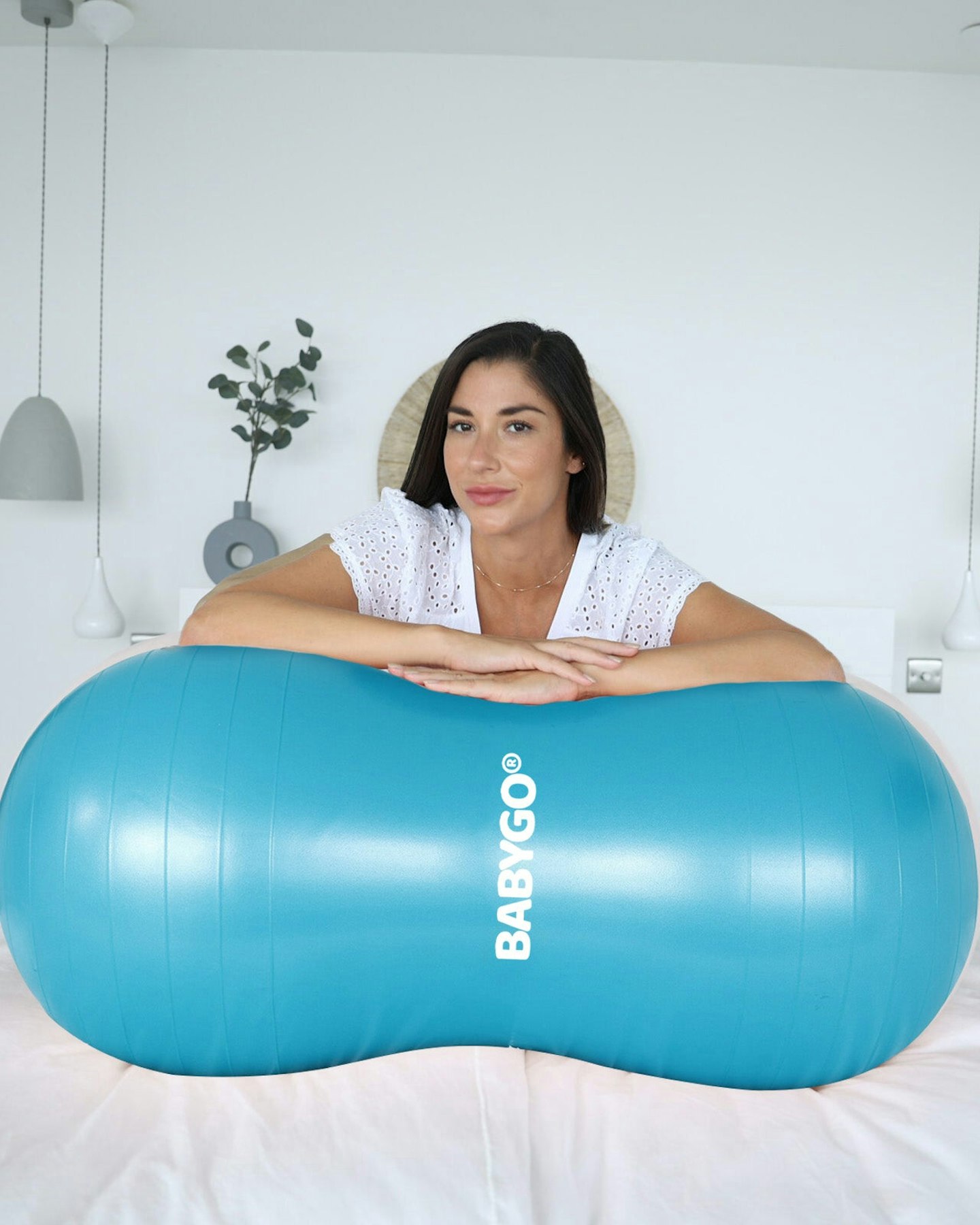
The BABYGO Peanut Ball stands out with its unique shape, offering extra stability and support compared to traditional round balls. Its design helps in encouraging optimal fetal positioning, which can be beneficial during labor. Strong and versatile, this ball is easy to inflate and deflate, making it a practical choice for your birthing and exercise needs.
One reviewer said: "I bought this for my daughter after the midwife recommended it. It’s great for balance and adaptability. Easy to use and inflate. A fantastic purchase!”
Pros
- Unique peanut shape provides enhanced support and stability
- Helps with optimal fetal positioning
- Strong and durable with easy inflation and deflation
- Can be used for yoga and physiotherapy
Cons
- Size may not be suitable for shorter individuals
- Pump could be higher quality
| Dimensions: | 50cm |
| Colour: | Blue |
| Pump included: | Yes |
| Weight: | 1.7kg |
- 1 x Peanut Ball
- 1 x manual
- 1 x pump
- 1 x ball plug
- 1 x plug remover
- 1x tape measure
Birthing Ball FAQs
How to use a birthing ball
Getting comfortable with your birthing ball is key to making the most of its benefits. Start by inflating the ball and practicing some of the exercises we’ve discussed. When you first try it out, place the ball on a carpet rather than a smooth floor to prevent it from sliding around. Having someone stand by to help you balance can also be useful, especially if you’re new to using the ball.
For safety and stability, it’s best to use the ball while barefoot. If you prefer to wear shoes or socks, make sure they have a non-slip grip to avoid any mishaps. With a little practice, you’ll find your rhythm and can enjoy all the benefits the birthing ball has to offer! Experts say when you use the birthing ball during labour, you will feel pain relief after 20 to 90 minutes.
Can a birthing ball help start labour?
Using a birthing ball during labour can make a big difference. Research shows it can help reduce the need for medical interventions and may even shorten the time you spend in labour. Other studies suggest thatbouncing or sitting on the ball might increase the chances of starting labour naturally. So, if you’re looking for ways to ease your labour experience, incorporating a birthing ball could be worth a try.
How can I use my birthing ball after birth?
Your birthing ball can be a valuable tool even after your baby arrives. For breastfeeding, it provides comfortable support, allowing for gentle bouncing that can help soothe your baby and make latching easier. The ball is also perfect for calming a fussy baby with its gentle rocking and bouncing motions. Additionally, incorporating the ball into your post-natal exercise routine can aid in regaining core strength and flexibility, with exercises like pelvic tilts and gentle stretches. Finally, using the ball as a chair promotes better posture and back relief by encouraging active sitting, making it a beneficial addition to your daily routine.
About the experts
Jacqui Kingswell, co-founder of the The Birthing Class and The Pilates Class, has had a lifelong passion for dance and Pilates. She worked as a professional dancer, touring and collaborating with international artists. Having practiced Pilates since age 12, Jacqui learned to love, respect, and care for her body through a holistic approach to health and well-being. In 2020, she co-founded The Pilates Class with Natasha Oakley, offering online Pilates classes worldwide. During her first pregnancy in 2023, Jacqui felt overwhelmed by the lack of empowering information for expectant mothers, leading her to create The Birthing Class.
Dr Penelope Law is a consultant obstetrician, gynaecologist and member of the Luna Daily Medical Collective. She is renowned for her pioneering research in non-invasive techniques for treating uterine fibroids, earning global recognition and positioning her as an advocate for alternatives to traditional surgery. Dr Law's extensive research on obesity during pregnancy led her to establish and oversee an NHS antenatal obesity clinic in London, demonstrating her commitment to addressing critical health challenges for pregnant women.
Hana Pauls is a midwife at Liverpool Women’s Hospital, where she delivers babies and cares for new mums. Featured in the past three series of Channel 4’s hit show One Born Every Minute, Hana is known for her reassuring presence during labour. With 15 years of experience as a midwife, she has delivered over 1,000 babies, providing expert care and support to countless families.
Hollie Grant is the founder of Pilates PT and creator of The Bump Plan. As a Tatler award- winning personal trainer, highly experienced Pilates expert and advanced prenatal specialist, Hollie is passionate about encouraging women to think of their bodies not by dress size, but by its function, performance and capabilities.
About the author
Anne Lora Scagliusi is a Senior Digital Writer at Mother & Baby. She is a Scotland-based journalist with over a decade of international writing experience, specialising in women’s health, maternal mental health, and wellness. Her work has been featured in Vanity Fair, Marie Claire, and Glamour and has appeared on several Vogue global editions. She is mum to a one-year-old bambino and lives between Italy and the UK.

